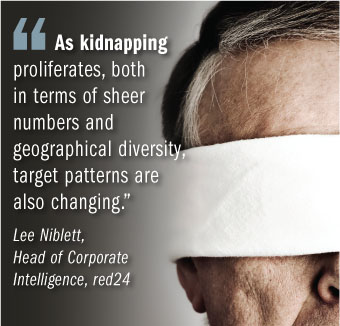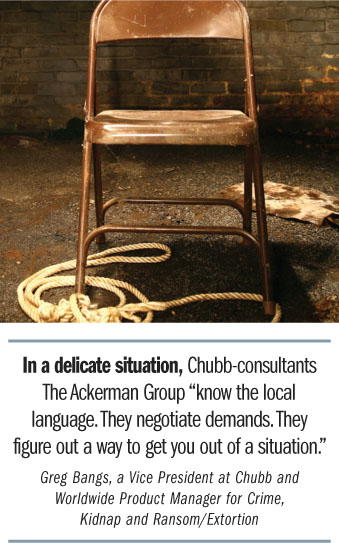 Kidnap, Ransom and Extortion(KRE) insurance has become a coverage shaped both by intensecarrier competition and a growing global need for it amongcorporations and the wealthy.
Kidnap, Ransom and Extortion(KRE) insurance has become a coverage shaped both by intensecarrier competition and a growing global need for it amongcorporations and the wealthy.
Kidnapping and extortion has become an industry of highlyorganized, often technologically advanced criminal groups lookingto make a statement, a quick buck—or both.
|Data suggests kidnappings may have risen 10 percent from levelsin 2010 to more than 30,000 recorded incidents. Traditionallyhigh-risk areas remain troublesome, while new hotspots areconstantly emerging.
|Experts say even these sobering statistics belie the trueenormity of the problem. Perhaps as many as 80 percent of incidentsgo unreported, or are misreported, for a variety of reasons—fromfear of retaliation to the fact that in some cases, localauthorities may be in on the plot.
|The objective and measure of KRE success is consistentthroughout the insurance industry: the successful return of adetainee, alive.
|And the mostly secretive process of achieving that goal reliesupon a delicate formula of knowledge, patience and force.
|DEMAND UP, BUT FIERCE COMPETITION KEEPS PRICES INCHECK
|Primary players in the KRE insurance market are experiencingupticks in submissions approaching 30 percent in some cases,according to broker Burns & Wilcox. “They also reportcontinually increasing written-premium volumes,” says Jeff Bogen,Professional Liability underwriter and broker for B&W.
|Executives say news-media reports at home and abroad havebrought the dangers—and subsequently, the need for insurancecoverage—to the forefront.
|“We hear about [an incident] every day now on the news:abductions, piracy, terrorism, citizens trapped in a country,” saysCarl Swanson, CNA's assistant vice president of underwriting andhead of global contingency risk.
|“Media coverage has definitely added to the increase ininterest,” agrees Greg Bangs, a vice president at Chubb andworldwide product manager for crime, kidnap and ransom, andextortion. “But you can also look at how businesses are operatingthese days, with more employees being asked to relocate ortravel.”
|As more and more companies—as well as some high-net-worthindividuals—become aware of the coverage, more insurers areimproving products or looking to get into the niche. Carriercompetition is fierce, which is keeping pricing attractive forbuyers even as demand rises.
|“With more products available to consumers and more insurancecompanies wanting in on the action, pricing has become verycompetitive,” says Bogen. “One-million-dollar limits for $1,000annual premium can easily be had.”
|Alex Pittignano, V.P. of crisis management at Starr Cos., saysmany of the submissions the insurer sees are from first-timepurchasers.
|Indeed, while KRE coverage has been on the radar screen ofmultinational, Fortune 1000 companies for years, theincreasingly global economy has inspired a demand among a muchlarger swath of businesses.
|CNA, in fact, just launched a new KRE product, targeted squarelyat middle-market businesses beginning to globalize.
|Bangs says as more employees are stationed in foreign countries,their safety and well-being (as well as litigation avoidance) are“definitely factors in the product purchase.”
|What is known as “duty of care” for expatriate and localemployees has been a big push in KRE products' increased popularityas employers look to avoid lawsuits, notes Tracie Thompson, globalhead of kidnap and ransom for Chartis.
|WHAT'S COVERED?
|Policies, issued on an indemnity basis, can cover more than thenamed insured. An incomplete list includes spouses, children,stepchildren, guests in the home and employees of the household.Standard policies cover kidnap, ransom, hijacking, wrongfuldetention, extortion, legal liability and related expenses.
|These policies are often used by insureds as collateral withbanks to raise cash with which to pay ransoms.
|While policies in the past were structuredmainly to address the needs of large, for-profit multinationals,offerings can now specifically be tailored for such entities aseducational institutions and hospitals (for abducted employees orstudents); or for churches (to cover missionaries).
| The risks that may not beincluded in a standard policy (disappearance, piracy or politicalevacuation, for example) can be tacked on via endorsements.
The risks that may not beincluded in a standard policy (disappearance, piracy or politicalevacuation, for example) can be tacked on via endorsements.
Coverage can also be held by businesses for protection againstcyber extortion—a threat that an entire computer system will behacked to cause a disruption or to steal a trade secret if a ransomis not paid. A threat of product contamination is anotherpossibility that insurance can cover.
|WHEN THE CALL COMES IN…
|Carriers have aligned themselves with private firms—staffed withformer intelligence officers and personnel trained in hostagerescue—that are ready to advise on a litany of KRE-relatedsituations, gauge the legitimacy of threats and respond directly toa crisis.
|“When the client is aware something has happened, they call anincident hot-line number that gives them instant access toconsultants who have personnel who can be deployed to a situationimmediately,” says Thompson of Chartis, which uses consultancy firmNYA International.
|The first few hours after a kidnapping or extortion notice arecritical, which is why insurers say they remain out of the way andallow consultants to work “behind closed doors,” says Thompson.
|“The role of the consultant is to work on behalf of theinsured,” explains Richard Bessinger, senior vice president ofStarr Indemnity & Liability Co. “The consultants are there toprovide advice and guidance to insureds in extremely emotionaltimes, to allow the insured to make informed decisions.”
|The strategy here is to give the insured “no disincentive whenusing [crisis-management services],” adds Pittignano. There is nodeductible for use of the consultant, and no cap on theconsultancy's cost during an insured event.
|Thompson says the consultants handle the delicate task ofnegotiations, with enough knowledge of when (and what) to pay inorder to deter the kidnappers or extortionists from strikingagain.
|These consultants' services are the driving force behind thepurchase of many KRE policies, Bessinger says.
|“They come in immediately,” adds Bangs of Chubb, which uses TheAckerman Group as a consultant. “They know the local language. Theynegotiate demands. They figure out a way to get your employee outof a situation.”
|One recent real-world example: red24—a globalsecurity-assistance and crisis-response firm that counts CNA amongits clients—helped 185 people to get out of Egypt during politicalunrest there last year, according to the firm's Web site.
|In some instances, this involved simple transportation. Inothers, “more sophisticated security operations” were needed, red24notes, discreetly.
|RISK AWARENESS PLAYS PIVOTAL ROLE
|Preventative measures provided by these private consultanciesmake KRE “more than a traditional risk transfer,” says Chartis'Thompson. “Our specialists can help our clients become moreproactive.”
|For instance, shipmasters contact a consultant every three hoursto coordinate routes in real time, says Pittignano: “The role ofconsultants is so important. Informed clients can do so much toavoid potential problems by working with consultants.”
| Employees can be briefed beforethey travel or relocate to learn caution measures of their own,such as never establishing an identifiable routine.
Employees can be briefed beforethey travel or relocate to learn caution measures of their own,such as never establishing an identifiable routine.
“[Criminals] can take a lot of time getting to know you onceyou're targeted,” says Bangs, who relates a story about a man whowas kidnapped after his abductors watched him until they learnedhis habits.
|“He'd back out of the driveway in his car each morning to gethis [delivered] newspaper,” notes Bangs. “If the paper was on thedriver's side, he wouldn't get out—he just opened the door andreached down.
|“The guys watching him picked up on it and moved the newspaperto the passenger side,” he continues. “When he got out to get it,they took him.”
|HOTSPOTS MULTIPLY ABROAD
|The evolution in coverage has been paralleled by theproliferation of KRE hotspots.
|A decade ago, Latin America accounted for a large majority—maybeas much as 90 percent—of all reported KRE incidents. But today,factors such as political and economic unrest have led to a highfrequency of kidnap-and-ransom incidents in territories around theworld.
|Lee Niblett, head of corporate intelligence at red24, says theMiddle East and North Africa have seen significant growth in KREincidents: “Conflict in Afghanistan and Iraq has createdsignificant instability, providing an ideal environment for bothcriminal and insurgent groups to conduct kidnappingoperations.”
|There has also been an escalation in KRE incidents in Yemen andSomalia, Niblett reports.
|Nigeria is one of the world's highest-risk areas, and incidentshave increased in Pakistan and India. The threat also exists in thePhilippines and China.
|“As kidnapping proliferates, both in terms of sheer numbers andgeographical diversity, target patterns are also changing,” addsNiblett.
|Organized KRE gangs, he explains, stay on top of trends. They'vestudied their targets to determine which are most likely to end ina quick ransom payment—which is one main reason why carriers,brokers and buyers remain adamantly mum on whether or not aspecific organization has the coverage.
|“The existence of a policy must be kept confidential as much aspossible,” Bogen explains. “This helps avoid staged/collusivesituations which are obviously not covered. A policy worth itsweight will request as much confidentiality as possible but notvoid cover if some people know about it. Ideally, those who need toknow, do know. But no one else does.”
|While one might expect an organization's leaders to be the toptargets, that's actually not the case. Mid-level managers,government officials, project workers and lower-level businesspersonnel find themselves victimized more often, says Niblett.While most victims are local nationals, he adds, “foreign nationalsare not immune from the threat.”
Want to continue reading?
Become a Free PropertyCasualty360 Digital Reader
Your access to unlimited PropertyCasualty360 content isn’t changing.
Once you are an ALM digital member, you’ll receive:
- All PropertyCasualty360.com news coverage, best practices, and in-depth analysis.
- Educational webcasts, resources from industry leaders, and informative newsletters.
- Other award-winning websites including BenefitsPRO.com and ThinkAdvisor.com.
Already have an account? Sign In
© 2024 ALM Global, LLC, All Rights Reserved. Request academic re-use from www.copyright.com. All other uses, submit a request to [email protected]. For more information visit Asset & Logo Licensing.








